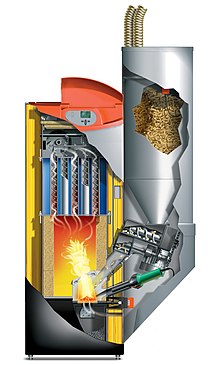


Apellet boiler is a heating system that burns wood pellets. Pellet boilers are used in central heating systems for heat requirements (heating load) from 3.9 kW (kilowatt) to 1 MW (megawatt) or more. Pellet central heating systems are used in single family homes, and in larger residential, commercial, or institutional applications. Pellet boiler systems run most efficiently at full load and can usually be regulated down to 30% of full load. Since the warm up phase of pellet boilers usually takes longer than for oil or gas firing systems, short burning phases have negative effects on the fuel efficiency. In order to improve energy efficiency and reduce harmful emissions, pellet boilers are usually combined with buffer systems, such as insulated water tanks.[1]

Similar to wood chip heating systems, pellet fuel is delivered periodically and automatically from the pellet storage (for central heating systems) or the day tank (for a pellet stove) according to need in the combustion chamber. With the heat generated from the burning pellets, circuit water is heated in the boiler of the pellet. The heat distribution is the same as in other systems, which use water for heat distribution. Unlike oil or gas heating systems, pellet heating systems require the integration of a hot water tank in the heating system in order to reduce heat losses.

The furnace is automatically supplied with combustible material. The control technology of the system regulates the fuel input gradually in order to match the required heat output. Depending on the specific system, the supplied wood pellets are automatically ignited either with hot air blowers or from a permanent ember bed in the combustion chamber.
Wood pellet heating systems work with different techniques of charging and combustion. There are specifically developed loading techniques for pellet combustion, like drop chute firing, underfeed firing, side-fed firing, or the use of a roller grate system. The method of charging and combustion of the pellet fuel is divided into 5 technologies.[2]
For more efficiency and less pollution in the air, modern pellet heating systems control combustion either via a temperature or flame space sensor in combination with an infinitely variable input of combustion air via a suck-blow fan or a lambda probe. The hot flue gases are led into the chimney via a heat exchanger with manual or automatic cleaning of the reheating surfaces.

Pellet systems are available in different power ranges from about 3.9 Kilowatt single ovens between about 4 and 20 kW. Most systems available today have a power control over the fuel and combustion air supply, so that they can be operated at full load and at part load. Currently pellet boilers achieve a combustion efficiency of about 85-95% at full load (nominal thermal output) in thermal power operation.
With few exceptions, the efficiency decreases when the pellets boiler operates at partial load. The technical heating efficiencies described may vary greatly from the actual plant efficiencies, the reason the plant concept plays a major role. The use of a sufficiently large buffer storage is useful.
The wood pellets are stored in bulk in a tank or storage area and supplied to the burner by means of a conveyor system.[3] The storage area must be dry, since the pellets react hygroscopically on clammy walls or in high humidity during storage with crumbling.
Compared to oil, wood pellets require about three times the storage volume, though with less technical effort for the space, as unlike pellets, heating oils are water-polluting substances. For storage, the pellets can be accommodated in a single storage space. The floor should be in the shape of a funnel usually made out of wood. At the end of the funnel is the inlet for the screw conveyor or the extraction pipe. More outlets in the storage room ensure unobstructed operation even in case of problems of one of the extraction points. Alternatives to a storage room are prefabricated tanks made of fabric or sheet steel.[4] Buried underground tanks or free-standing silos can be used, if sufficient space is available in the building. In areas with high humidity it is important to use must tight tank systems to ensure the quality of pellet fuel.
To convey the pellets from the storage facility to the boiler room, blower or screw systems can be used. The choice depends primarily on the distance from the storage to the boiler room. For distances greater than two meters, flexible multi-stage screw conveyors are usually necessary. Blower systems can be used flexibly and feed distances up to 20 m. The discharge from the storage room or container is usually also supported by an inclined tank bottom or a hopper outlet.[5]